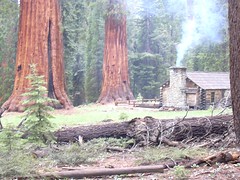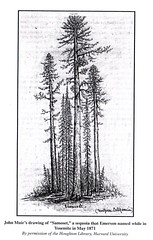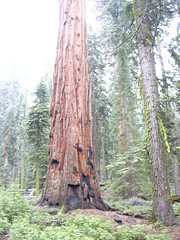Saturday, June 7, 2008
samoset
In the post below, I said there's only one tree I ever wanted to see in Mariposa Grove, and that's the one called Samoset.
From the parking lot at the Mariposa Grove trailhead, if you walk 2.5mi and 1200 feet up, you get to the upper grove. At the top of the mountain, after passing a few other named trees on the way up (Faithful Couple, Clothespin, etc), you get to the area of the (toilets and) "museum." The "museum" is really just a little cabin with a fireplace and a few posters on the ecology and history of the big trees. Check out the size of the trees next to the cabin. That's not some little lego cabin—it's probably 500 square feet and has a lovely porch. Those are just some really freaking big trees (their names are General Grant and General Sherman—but they are not the Generals Grant and Sherman in Kings Canyon National Park and Sequoia National Park, respectively.).
Check out the size of the trees next to the cabin. That's not some little lego cabin—it's probably 500 square feet and has a lovely porch. Those are just some really freaking big trees (their names are General Grant and General Sherman—but they are not the Generals Grant and Sherman in Kings Canyon National Park and Sequoia National Park, respectively.).
The cabin you see here was built in 1930 and restored in 1983. It sits on the site of Galen Clark's cabin, which he built in 1861. Here's a photo of the original cabin, taken before 1907, which is found in Clark's The Big Trees of California.
In the upper grove, the "famous" trees to see are the Galen Clark Tree (named for the man, duh) and the Fallen Wawona Tunnel Tree. But I didn't want to see the trees that everyone knows about. I wanted to see Samoset.
 Samoset is not marked in the popular guidebooks or the 50-cent pamphlet you pick up at the trailhead, and it doesn't have a sign in front of it. You can't find Samoset listed even in the better maps/guides/descriptions of trees, such as James W. McFarland's A Guide to the Giant Sequoias of Yosemite National Park from 1949, which includes this great "tour" with descriptions as well as this lovely map of the groves. All I really knew was that it was close to Galen Clark's camp/the museum and looked something like this sketch made 108 years ago (ha ha).
Samoset is not marked in the popular guidebooks or the 50-cent pamphlet you pick up at the trailhead, and it doesn't have a sign in front of it. You can't find Samoset listed even in the better maps/guides/descriptions of trees, such as James W. McFarland's A Guide to the Giant Sequoias of Yosemite National Park from 1949, which includes this great "tour" with descriptions as well as this lovely map of the groves. All I really knew was that it was close to Galen Clark's camp/the museum and looked something like this sketch made 108 years ago (ha ha).
 You'd think there'd be no way in hell I could find an unmarked tree in a grove of big trees, and you'd be right—except the keeper of the museum, who had just built the fire and was sweeping the porch, was a kindly and talkative fellow. I honestly don't remember how the conversation started, because I was too busy being entirely emotionally overwhelmed by the whole thing (as I am wont to do), but when I said "I don't suppose you know where Samoset is?" and he turned around and pointed directly at it.
You'd think there'd be no way in hell I could find an unmarked tree in a grove of big trees, and you'd be right—except the keeper of the museum, who had just built the fire and was sweeping the porch, was a kindly and talkative fellow. I honestly don't remember how the conversation started, because I was too busy being entirely emotionally overwhelmed by the whole thing (as I am wont to do), but when I said "I don't suppose you know where Samoset is?" and he turned around and pointed directly at it.
"You know who named it?" he said.
As if anyone who explicitly asked about this tree wouldn't know who named it? I thought to myself. "Emerson!" I said.
If I had been thinking, I would have brought Muir's sketch and recreated it in the photograph. I'm only slightly off, as you can see the pine tree to the right and another sequioia in the background. Since I screwed up the photo, I can't match up the burn scars to the sketch, to see if the burn happened before or after May 1871. But I know one thing—that tree isn't much different since the time Emerson and Muir stood in front of it and RWE named it—just nine more feet in diameter. Ha: "just."
From the parking lot at the Mariposa Grove trailhead, if you walk 2.5mi and 1200 feet up, you get to the upper grove. At the top of the mountain, after passing a few other named trees on the way up (Faithful Couple, Clothespin, etc), you get to the area of the (toilets and) "museum." The "museum" is really just a little cabin with a fireplace and a few posters on the ecology and history of the big trees.
 Check out the size of the trees next to the cabin. That's not some little lego cabin—it's probably 500 square feet and has a lovely porch. Those are just some really freaking big trees (their names are General Grant and General Sherman—but they are not the Generals Grant and Sherman in Kings Canyon National Park and Sequoia National Park, respectively.).
Check out the size of the trees next to the cabin. That's not some little lego cabin—it's probably 500 square feet and has a lovely porch. Those are just some really freaking big trees (their names are General Grant and General Sherman—but they are not the Generals Grant and Sherman in Kings Canyon National Park and Sequoia National Park, respectively.).The cabin you see here was built in 1930 and restored in 1983. It sits on the site of Galen Clark's cabin, which he built in 1861. Here's a photo of the original cabin, taken before 1907, which is found in Clark's The Big Trees of California.
In the upper grove, the "famous" trees to see are the Galen Clark Tree (named for the man, duh) and the Fallen Wawona Tunnel Tree. But I didn't want to see the trees that everyone knows about. I wanted to see Samoset.
 Samoset is not marked in the popular guidebooks or the 50-cent pamphlet you pick up at the trailhead, and it doesn't have a sign in front of it. You can't find Samoset listed even in the better maps/guides/descriptions of trees, such as James W. McFarland's A Guide to the Giant Sequoias of Yosemite National Park from 1949, which includes this great "tour" with descriptions as well as this lovely map of the groves. All I really knew was that it was close to Galen Clark's camp/the museum and looked something like this sketch made 108 years ago (ha ha).
Samoset is not marked in the popular guidebooks or the 50-cent pamphlet you pick up at the trailhead, and it doesn't have a sign in front of it. You can't find Samoset listed even in the better maps/guides/descriptions of trees, such as James W. McFarland's A Guide to the Giant Sequoias of Yosemite National Park from 1949, which includes this great "tour" with descriptions as well as this lovely map of the groves. All I really knew was that it was close to Galen Clark's camp/the museum and looked something like this sketch made 108 years ago (ha ha). You'd think there'd be no way in hell I could find an unmarked tree in a grove of big trees, and you'd be right—except the keeper of the museum, who had just built the fire and was sweeping the porch, was a kindly and talkative fellow. I honestly don't remember how the conversation started, because I was too busy being entirely emotionally overwhelmed by the whole thing (as I am wont to do), but when I said "I don't suppose you know where Samoset is?" and he turned around and pointed directly at it.
You'd think there'd be no way in hell I could find an unmarked tree in a grove of big trees, and you'd be right—except the keeper of the museum, who had just built the fire and was sweeping the porch, was a kindly and talkative fellow. I honestly don't remember how the conversation started, because I was too busy being entirely emotionally overwhelmed by the whole thing (as I am wont to do), but when I said "I don't suppose you know where Samoset is?" and he turned around and pointed directly at it."You know who named it?" he said.
As if anyone who explicitly asked about this tree wouldn't know who named it? I thought to myself. "Emerson!" I said.
At the request of Galen Clark, our host at Mariposa, & who is by State appointment the Protector of the trees, & who went with us to the Mammoth Groves, I selected a Sequoia Gigantea, near Galen's Hospice, in the presence of our party, & named it Samoset, in memory of the first Indian ally of the Plymouth Colony, and I gave Mr. Clark directions to procure a tin plate, & have the inscription painted thereon in the usual form of the named trees;If you study Emerson and Muir, it's one of those things you know, since they only met once and the story has been retold from various points of view and it's important to know them all. At the end of Muir's "The Forests of the Yosemite Park", from the April 1900 Atlantic, you can read his account of the event.
Samoset—
12 May
1871
& paid him its cost. The tree was a strong healthy one, girth at 2.5 feet from the ground, 50 feet.—The Journals and Miscellaneous Notebooks of Ralph Waldo Emerson, Volume XVI (1866-1882), p. 239
If I had been thinking, I would have brought Muir's sketch and recreated it in the photograph. I'm only slightly off, as you can see the pine tree to the right and another sequioia in the background. Since I screwed up the photo, I can't match up the burn scars to the sketch, to see if the burn happened before or after May 1871. But I know one thing—that tree isn't much different since the time Emerson and Muir stood in front of it and RWE named it—just nine more feet in diameter. Ha: "just."
Labels: outdoorsy